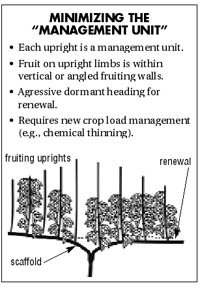 Orchard systems must evolve into highly efficient systems if growers are to stay competitive and profitable, says a Washington State University scientist.
Orchard systems must evolve into highly efficient systems if growers are to stay competitive and profitable, says a Washington State University scientist.
Cherry growing in the future will require a new way of thinking, noted Dr. Matthew Whiting, horticulturist at WSU’s Prosser research station.
A common theme of much of Whiting’s research is to maximize grower profitability. To accomplish this, he is studying efficient orchard systems, crop load management, and working to maximize packout of target fruit.
“We need to treat tree pruning in a systematic way instead of as an art,” he said, adding that minimizing the “management units” of a canopy will encourage uniformity and allow orchardists to more easily train workers. “It’s much easier to train workers to do the same motion over and over.”
Random limbs
The Pacific Northwest cherry industry is studying how to configure orchards to be compatible with mechanical cherry harvesters and mechanical aid equipment, such as platforms for pruning. Whiting and others are evaluating different tree designs to learn what works best with mechanical aids and creates an efficient orchard system. The research is funded by the Oregon Sweet Cherry Commission and Washington Tree Fruit Research Commission.
The biggest drawback to current tree designs is the random placement of limbs, he explained.
His vision for an efficient orchard system is a tree-training system that produces angled or upright fruiting walls, with angles of 55 to 65 degrees from horizontal. Fruiting would take place on vertical uprights, which would be spaced about 18 inches apart.
Y trellis trials
Orchard system trials are under way, comparing the traditional Y trellis, which provides two angled planes of fruit on either side of the tree, to an alternating Y trellis. The alternating Y trellis provides multiple fruit on upright limbs that come off two main scaffolds.
The alternative configuration requires aggressive dormant heading for renewal wood, he said. “Each upright then becomes the management unit.”
Marrying tree design with technology will enable cherry growers to incorporate new technology and equipment, such as over-the-row sprayers that recycle and reduce chemical sprays. Canopy and fruit vision technology could also be employed to improve crop estimating.
“Rather than thinking of trees per acre, we should be thinking of management units
It then becomes easy to manage crop loads to reach specific tonnage targets, he added. To achieve eight tons per acre, growers would strive to have four pounds of fruit per branch. He notes that it is much easier to target four pounds per branch than 28 pounds per tree or even 14 pounds per alternating side.
Preliminary data from Whiting’s orchard system research showed that in the third leaf, alternating Y trees produced 3.4 tons per acre for Bing on Gisela 12 and 2.9 tons per acre for Skeena on G.5. Tieton on G.5, grown on the traditional Y, yielded 0.65 tons per acre.

Leave A Comment